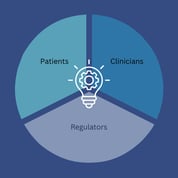Switzerland (Head Quarters)
IDR Medical Switzerland
Austrasse 95, CH-4051 Basel, Switzerland
T:
+41 (0) 61 535 1109
UK
IDR Medical UK
Unit 104 Eagle Tower, Eagle Tower
Montpellier Drive, Cheltenham, GL50 1TA
T:
+44 (0) 1242 696 790
USA
IDR Medical North America
225 Franklin Street, 26th Floor
Boston, Massachusetts 02110, USA
T:
+1 (0) 617.275.4465

Why AI Should Not Be Used for Diagnosing Patients
AI is transforming healthcare, but in diagnostics, the technology remains far ahead of its clinical readiness.
For MedTech leaders, the risk isn’t missing out on innovation; it’s mistaking early potential for proven performance.
- Diagnostic AI still fails fundamental tests of safety, transparency, and generalizability.
- Regulators are tightening scrutiny faster than the market expects.
-
The competitive advantage now lies in responsible leadership, not rapid deployment.
The Strategic Temptation of Diagnostic AI
Artificial intelligence is reshaping every corner of healthcare, from scheduling to imaging workflows. For MedTech executives, the allure is obvious: a diagnostic assistant that’s always available, infinitely scalable, and seemingly precise.
But that promise conceals a strategic trap. Diagnostic AI is not yet clinically reliable and not regulatory-ready. Deploying it prematurely invites a triple threat: patient harm, compliance violations, and reputational damage.
As the 2025 report from the Peterson Health Technology Institute highlighted, while ambient AI scribe tools show promise in reducing clinician burnout, their financial impact remains unclear.
Case Study 1: ChatGPT-3.5 and Diabetic Foot Ulcer Care
A 2024 study evaluated ChatGPT-3.5 on common questions about diabetic foot ulcers (DFUs). On paper, the results looked impressive:
- Accuracy: 8.7/10
- Comprehensiveness: 8.0/10
Yet beneath those headline metrics:
- Three answers contained outright misinformation.
- Ten of eleven omitted essential clinical details.
- The writing level exceeded typical patient comprehension.
Implication: Apparent accuracy can conceal dangerous omissions.
🔑 Executive Takeaway: When “plausible” errors scale through automation, they don’t scale care, they scale risk.
Case Study 2: Microsoft Copilot in Chronic Wound Assessment
A second evaluation tested Microsoft Copilot’s ability to identify chronic wounds. Results showed:
- The correct diagnosis ranked first only 30% of the time.
- It appeared within the top three in 70% of cases.
In consumer tech, 70% accuracy might be acceptable. In medicine, a 30% miss rate can be catastrophic.
🔑 Executive Takeaway: Diagnostic reliability must exceed consumer-grade benchmarks. A single wrong “first guess” can have life-and-death consequences.
Case Study 3: Ambient-AI Scribe Deployment in U.S. Health Systems
Mass General Brigham, a prominent U.S. health system, initiated the use of ambient-AI documentation tools in 2023 to alleviate clinician burnout and enhance documentation efficiency. By 2025, the system had expanded its deployment to over 3,000 clinicians.
These AI-powered tools transcribe patient-clinician conversations into structured clinical notes in real-time, aiming to reduce the administrative burden on healthcare providers. While early feedback indicates improvements in clinician satisfaction and reductions in after-hours documentation, concerns have been raised regarding the regulatory oversight of such technologies.
A 2025 commentary in npj Digital Medicine highlighted that many ambient-AI scribes operate without full regulatory review, potentially bypassing necessary safety and efficacy evaluations. This lack of oversight could lead to issues related to documentation accuracy, data privacy, and integration with existing electronic health record systems.
🔑 Executive Takeaway: This is not a story of enforcement, but of a system that is adopting AI scribes, while still grappling with the oversight, accuracy, and safety implications. For MedTech leaders, the imperative is clear: treat documentation-AI deployments with the same rigor as diagnostic-AI deployments.
The Bigger Picture: Risk, Responsibility and Market Reality
AI continues to show promise across imaging, pathology, and predictive analytics. Yet every real-world deployment exposes the same foundational issues:
- Data fragility: Training datasets remain small, homogenous, and non-representative.
- Algorithmic opacity: Most models still operate as “black boxes,” preventing clinical validation.
- Systemic bias: AI often amplifies inequities already present in healthcare data.
Until these gaps are closed, diagnostic AI cannot meet the transparency, reproducibility, and safety thresholds that medical devices require. And without that assurance, adoption will stall, not because regulators say “no,” but because clinicians and patients won’t say “yes.”
The Leadership Imperative: From Adoption to Accountability
For C-suite MedTech leaders, this is not an argument against AI, it’s a call for disciplined strategy. The organizations that thrive will be those that embed responsibility as a core innovation principle, not a compliance afterthought.
Here’s what that leadership looks like in practice:
- Define AI as Assistive, Not Diagnostic
Position AI as a clinical support tool, not a decision-maker. Empower clinicians with better information, but never let the algorithm have the final word.
- Validate as You Would a Device
If you wouldn’t launch a physical device without clinical evidence, don’t deploy an algorithm without equivalent validation. Treat AI testing as an extension of device clinical trials - rigorous, transparent, and auditable.
- Build Explainability into Design
Transparency is the new trust currency. Ensure your models can be interrogated and understood by clinicians. An algorithm that can’t be explained can’t be defended.
- Engage Regulators Early
Don’t wait for mandates. Shape them. Early engagement with regulatory bodies allows your organization to anticipate compliance shifts and potentially influence the frameworks that will govern the industry.
- Differentiate Through Responsibility
Market leadership in MedTech is increasingly defined by trust, not just technology. Companies that embed safety and ethics into their AI strategies will enjoy sustainable competitive advantage, stronger investor confidence, and faster adoption.
The Strategic Opportunity Hidden in Caution
 The global AI healthcare market is expanding rapidly, but trust remains its gating factor. The next wave of industry leaders will not be those who deploy AI first, but those who deploy it safely, sustainably, and credibly.
The global AI healthcare market is expanding rapidly, but trust remains its gating factor. The next wave of industry leaders will not be those who deploy AI first, but those who deploy it safely, sustainably, and credibly.
Responsible adoption isn’t a brake on innovation; it’s the mechanism that will allow innovation to endure.
In diagnostics, “close enough” is never enough. Medicine demands validation, not speculation.
Leadership Beyond the Algorithm
The future of MedTech will be defined by how effectively leaders balance ambition with accountability. AI has immense potential to transform care - but not before it earns its place in the clinical workflow.
accountability. AI has immense potential to transform care - but not before it earns its place in the clinical workflow.
For today’s executives, the question isn’t “Can we use AI for diagnosis?” It’s “How can we lead AI adoption responsibly enough to make it viable tomorrow?”
The real competitive edge lies in credibility. When patients, clinicians, and regulators trust your approach, innovation follows naturally.
How IDR Medical Can Help
At IDR Medical, we help MedTech leaders de-risk innovation through evidence-driven insight. Our research connects patient experience, clinician workflow, and market perception to help organization:
- Understand how trust is built, or lost around emerging AI technologies.
- Identify adoption barriers and map the path to responsible integration.
- Shape messages that balance innovation with safety, earning market confidence.
If your organization is exploring AI-enabled solutions or defining its position in this fast-moving space, our strategic research can help you lead with credibility and foresight.
👉 Let’s start the conversation. Together, we can ensure that when AI enters clinical workflows, it does so safely, sustainably, and successfully.
Sources:
Kwon, S., et al. (2025). Consulting the Digital Doctor: Efficacy of ChatGPT-3.5 in Answering Questions Related to Diabetic Foot Ulcer Care. Advances in Skin & Wound Care.
Aydin, O., et al. (2025). Diagnostic Accuracy of Microsoft Copilot Artificial Intelligence in Chronic Wound Assessment: A Comparative Study. Journal of Wound Care.
Mass General Brigham. (2025, April 27). Ambient Documentation Technologies Reduce Physician Burnout. https://www.massgeneralbrigham.org/en/about/newsroom/press-releases/ambient-documentation-technologies-reduce-physician-burnout
Topaz, M. (2025). Navigating the Uncharted Risks of AI Scribes in Clinical Practice. npj Digital Medicine. https://www.nature.com/articles/s41746-025-01895-6
Peterson Health Technology Institute. (2025). Early Evidence Shows AI Scribes Reduce Burnout, but Financial Impact Unclear. https://www.axios.com/2025/03/27/ai-scribes-reduce-burnout-financial-impact
Anderson, T. N. (2025). Evaluating the Quality and Safety of Ambient Digital Scribe Technologies. MCP Digital Health. https://www.mcpdigitalhealth.org/article/S2949-7612(25)00099-9/fulltext
Wang, H., et al. (2025). An Evaluation Framework for Ambient Digital Scribing Tools. npj Digital Medicine. https://www.nature.com/articles/s41746-025-01622-1
Mishuris, R., et al. (2025). How AI Can Help Providers Listen to Their Patients Better. Mass General Brigham. https://www.massgeneralbrigham.org/en/about/newsroom/articles/ai-ambient-documentation
Leung, T. I. (2025). AI Scribes in Health Care: Balancing Transformative Potential with Practical Challenges. JMIR Medical Informatics. https://medinform.jmir.org/2025/1/e80898
Topaz, M. (2025). Health Care's Rush to AI Scribes Risks Patient Safety, Researchers Warn.
Topol, E. (2019). Deep Medicine: How Artificial Intelligence Can Make Healthcare Human Again.
IDR Medical. (2025). Internal Analysis: Trust and Adoption Barriers in AI-Enabled MedTech.


